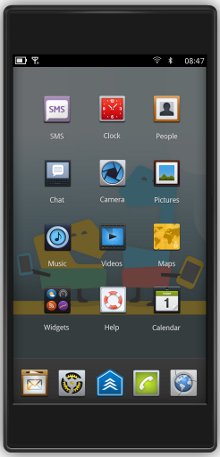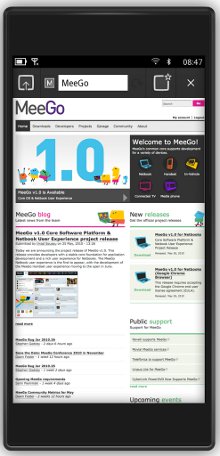Intel and Nokia pick MeeGo for mobile 3D research
Aug 24, 2010 — by LinuxDevices Staff — from the LinuxDevices Archive — viewsNokia, Intel and the University of Oulu have opened the newest branch of Intel Labs Europe, which will be dedicated to researching compelling new mobile user experiences — particularly in 3D. The “Intel and Nokia Joint Innovation Center” will be “well aligned” with the MeeGo open source platform launched earlier this year, the companies said.
Always wished that your mobile phone could project a 3D hologram of the person you're speaking with? The high-tech messaging scenario made famous by Star Wars could be an area of research at the Intel and Nokia Joint Innovation Center, the companies suggested in their announcement of the facility's official opening Aug. 24.
The newest member of Intel Labs Europe, the center, created in conjunction with Finland's University of Oulu, will employ about two dozen research and development professionals and focus on creating compelling mobile user experiences that leverage the capabilities of mobile devices — particularly those pertaining to 3D.
In February, Nokia and Intel together introduced the open-source mobile operating platform MeeGo, combining the Intel-backed Moblin with Nokia's Maemo distribution and Qt application framework. "MeeGo provides the greatest flexibility for developing new 3D experiences on mobile devices, as much of the lab's research activity will also be open source," the companies said in a statement regarding the new research center.


The MeeGo Handset environment was previewed last month
(Click on either to enlarge)
Justin Rattner, Intel's CTO and director of Intel Labs, stated that the University of Oulu's "focus on future telecommunications solutions, as well as electronics and photonics, made it the perfect location for the Intel and Nokia Joint Innovation Center."
Nokia CTO Rich Green said the new joint laboratory "draws on the Oulu research community's 3D interface expertise, and over time will lay down some important foundations for future mobile experiences."
During an Aug. 23 call with media and analysts, executives from the two companies — self-described as the number-one semiconductor company and the number-one handset company — as well as from the Center for Internet Excellence at the university, said a confluence of events is driving the project. These include increasing user experiences and interactions to fuel innovation; the proliferation of high-bandwidth Internet around the world; and mobile computing devices with capabilities that were inconceivable just three or four years ago.
The project is scheduled to run for three years, and possible outcomes could include not only advances in gaming, but location-based services and enterprise applications applicable, for example, for training purposes. It's also hoped that the trend of consumers becoming "prosumers," and interacting more directly with each other, could be encouraged. And again, the three have committed that any findings or technologies that develop as a result of the research will remain open source.
"Our role at Intel, continuously, is to develop technologies that compute ever faster, communicate ever faster and consume less and less power," Intel's director of Intel Labs Europe, Martin Curley, said during the call. "When we put these three opportunities together and work with Nokia, which has a very exciting range of products coming out and a very exciting vision of the future, this creates a recipe, or an environment, for I think some very compelling innovations."
When pressed as to whether a Star Wars-style hologram call was truly on the agenda, Mika Setälä, Nokia's director of strategy, alliances and partnerships, was forced to offer, "It was given as a visual guiding example of a very different user experience."
Pressed again, Setälä continued, saying, "Sometimes the movies offer a very good way of imagining the future. The way the 3D holograms were put forward almost 30 years ago by Lucasfilm is an extraordinary, visionary way of creating a communications interface. Are we able to repeat that or go that far? We definitely are giving it a go."
"That's the challenge," Intel's Curley added.
Michelle Maisto is a writer for our sister publication eWEEK.
This article was originally published on LinuxDevices.com and has been donated to the open source community by QuinStreet Inc. Please visit LinuxToday.com for up-to-date news and articles about Linux and open source.